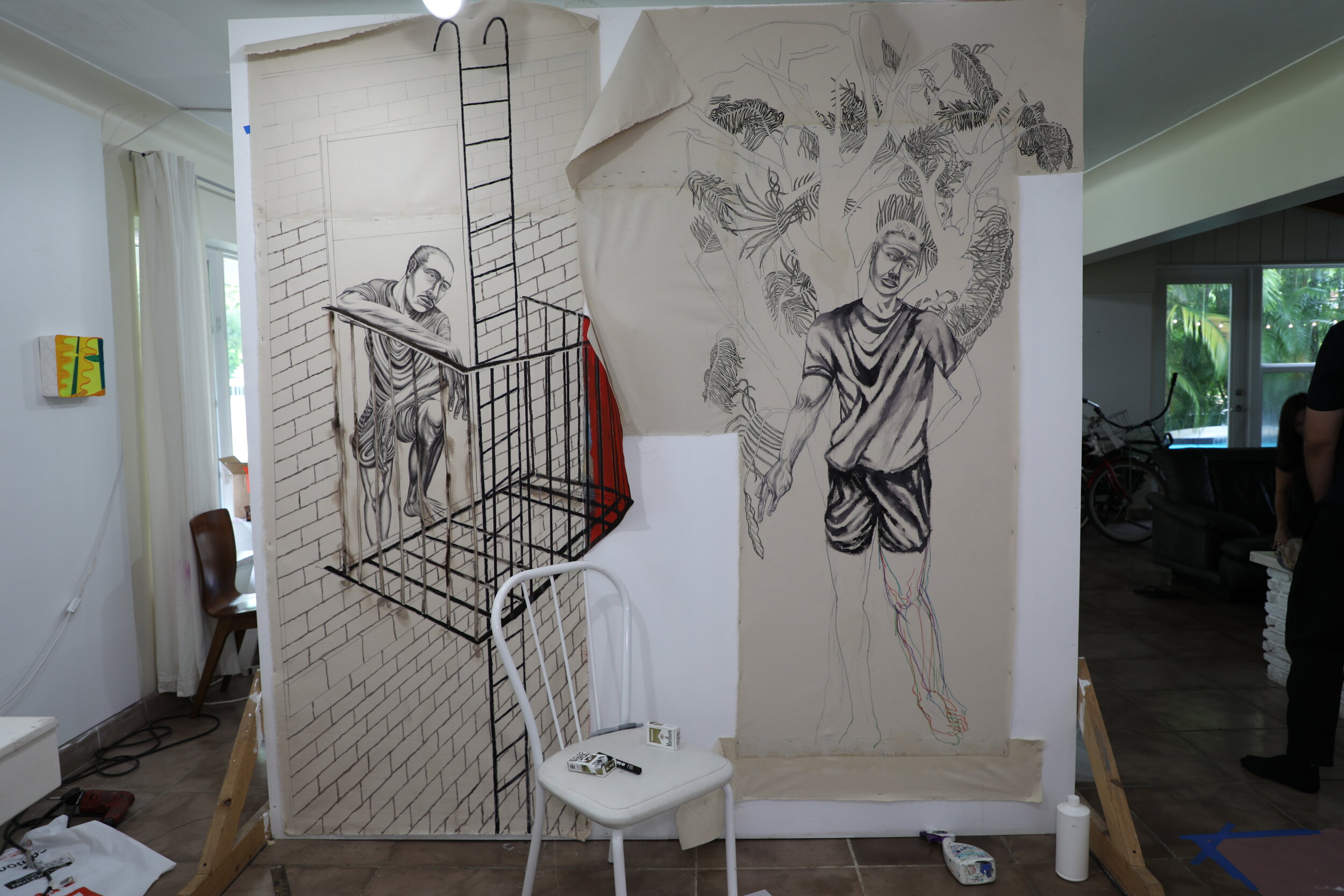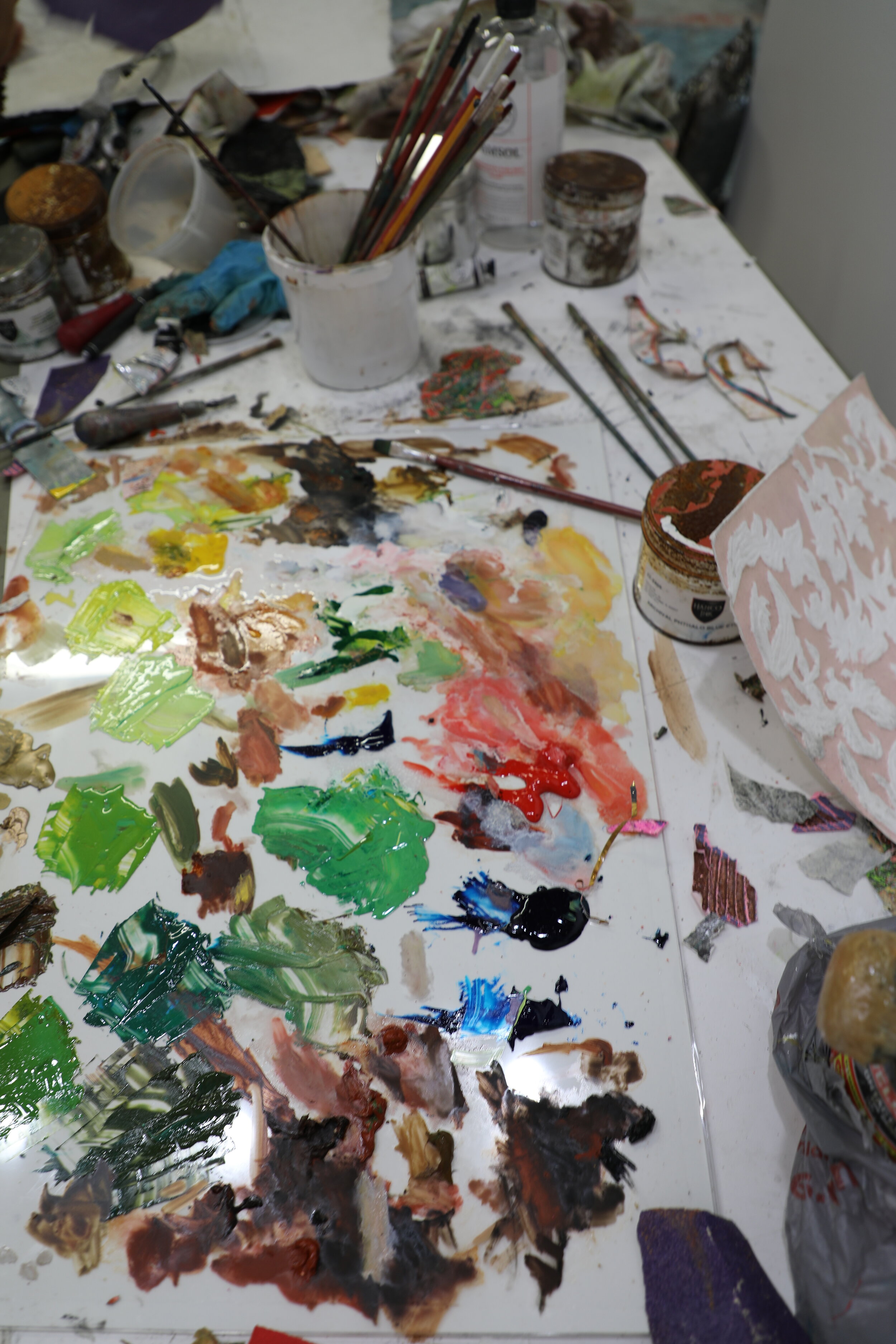September 2020
Images Courtesy of Alex Nuñez
Words by Nicole Martinez
Few experiences can replicate the comfort of home. Particularly when we feel anxious or uncertain about the future, home becomes a salve, a reminder of where we came from and a safe place from which to imagine the future. Replicating that level of intimacy often feels seamless at Fountainhead, as we welcome three artists into a home environment to live and create. In the months since COVID-19 has become a part of our daily reality - weighing on our psyches, shifting our plans, and driving us to seek relief in any form - Fountainhead has become a respite for self care. Nurturing artists with whatever they need - whether that’s space, a change of environment, or an opportunity - has become even more important to what we do.
September’s residency was certainly a homecoming. Beverly Acha, Erick Alejandro Hernandez, and Kathia St. Hilaire - once local artists who had each spent several years living and working outside the city - found themselves returning to Miami after the pandemic uprooted their plans. Living at home and desperate for space to create, they were able to secure space at Fountainhead Studios as they settled back into a new routine. But just as home can be a refuge, it can also suffocate creative pursuits - so we decided to offer the artists some time in Residence to help bring them back on course, in whatever way that felt right for them.
With Kathia taking the time to relax, catch up, and reflect; Erick finding the resolve to get back to work after having to postpone a major project; and Beverly juggling the demands of teaching with a full-time art practice, each artist found comfort in their camaraderie.
“Having a safe environment with two other artists made me feel like I'm living a life again,” Beverly noted. “Being with my studio mates also had a delightful impact on my mood; I was able to stop struggling to make work,” said Erick.
After so much time away, all three were invigorated by the pace of Miami’s art scene, and managed to find time for leisure and relationship building alongside making work.
“For me it’s like being in a new city,” said Erick. “There wasn’t as much stuff when I was growing up, and what there was I felt like I didn’t have access to,” said Erick.
“It made me feel like I wanted to make myself semi permanent here, which with all this uncertainty and not knowing when it will end, it’s exciting to know there’s this many possibilities,” said Kathia. “From meeting so many people at the residency to looking at other institutions and collections - people always say you have to live in New York to be an artist, but you see it’s not really the case.”
“To me what stands out about Fountainhead and what makes it unique from all the residencies I’ve done is that you're being connected to collectors and to curators,” said Beverly. “It got me thinking about what it takes to get artists out of Miami and into the world, while seeing just how many opportunities Miami has to offer.”
Beverly Acha
Beverly Acha’s multichromatic abstract canvases have a symphonic quality to them - their energy ripples through the wall, activating a sensorial experience by uniting loud color with fluid, organic shapes and clean lines. Often large-scale in size, Beverly’s aim is to envelope the viewer in her interpretation of an experience that has completely engulfed her: The warm glow of a sunset at dusk, for example, or the dark silhouette of a forest just before nightfall. She builds her color palette from the memory of that natural phenomena, while meditating on a human inability to truly recreate the intangible qualitymagic of such an event on a canvas or with a camera.
“Observation and visual phenomena are definitely at the core of my work,” says Beverly. “Light allows us to see color, so it is perceptual, but the experience of seeing compared to the way a camera captures fleeting color phenomena, is what I try to do through painting.”
Immersing herself in the experience of creating her work, Beverly says she will often start multiple paintings at once, spreading them out in her studio and assessing what the entire body of work is about before diving deeper into any one painting. The history of abstract painting informs her, but Beverly deliberately shifts to a diagrammatic style to understand the interplay between light, time and space. Rather than take a gestural or emotional approach to her abstractions, Beverly is methodical, and even scientific as she often turns to schematic drawings for inspiration, and incorporates repetition as a passageway to another dimension or time frame. While most geometric abstractionists work with brutally harsh lines, Beverly often softens their precision with curvature, adding a roundness to her canvas that again pays homage to nature - in particular, the cyclical and sacredly divine feminine, and how that cycle emerges consistently in the phenomena that inspires her work.
“I will usually start with a certain set of parameters ,sometimes focusing on a limited color palette, a specific size of brush, the repetition of a mark or shape across the surface, or a medium that impacts the way I manipulate the paint,” says Beverly.
With her residency at Fountainhead marking a return to Miami - Beverly arrived at Fountainhead with the intention of connecting with some of Miami’s influencers. “I feel like the blanket has been lifted and like I got a glimpse into what collectors are thinking about,” she says. “I feel like the blanket has been lifted and like I got a glimpse into what collectors are thinking about,” she says. “Studio visits with people from different parts of the art world in such quick succession lets you see the sort of ‘everything’ that helps the machine work.”
Erick Alejandro Hernandez
Erick Hernandez’s mixed media works are just asking you to step into them, transporting you to a surreal realm where horror and fantasy intertwine. Drawing inspiration from the gore of art historical religious painting, and then fusing that iconography with his own personal narrative, Erick’s looming works unravel psychological turmoil that borders autobiography, yet feels relatable. Hernandez is interested in how trauma infiltrates memory, often fracturing it as a method of survival. He finds insight into his subconscious through his work, conjuring images or figures that appear in dreams and daydreams, in a manner that’s both reparative and exploratory. In painting he can perceive his trauma; but he can also process it and heal.
Many of these figures appear again and again, suggesting an underlying need to revisit their significance. Most are starkly familiar examples of his upbringing in southwest Miami-Dade County - bright living rooms filled with Cuban relatives; potted plants under a patio terrace; and domino tables stacked with bottles of rum make up the backdrops of his immense paintings. He defies any one style, with some of his paintings taking a surrealist, dreamlike quality and others a more realist approach.
"I push myself to paint in as many ways as possible, and view that as a way of being prepared to respond to what the paintings ask of me," he says. "I am interested in having access to a broad repertoire of styles and developing a vocabulary of images and symbols that have personal meanings but also exist outside of myself.”
As another artist who prefers to immerse himself in his work - surrounding himself with works in progress to continue building on certain elements within the paintings, Erick notes that making paintings focused on memory while finding himself back home after so many years has been both challenging and insightful. Spending a month at Fountainhead may have been the break he needed.
“I think I noticed a shift when I was able to start working in my own space - I do really well with space, so when it feels private I can make that my little environment/ecosystem and come out into the world and feel a lot better about myself,” he says. “The whole experience has been an important opportunity to find respite from the state of the world and the direct consequences of Covid-19 on my life and practice.”
Kathia St. Hilaire
Creating a cacophony of textures using printmaking, embossing, and collaging techniques, Kathia St. Hilaire’s work is inspired by Haitian vodun flags and looks to key narratives from her childhood to inspire her work. She often draws a connection between the spiritual figures that appear on the flags and the rituals or customs that continue to subtly infiltrate Haitian culture, an allusion to the gripping and revolutionary power vodun has had over the island’s history. Putting an emphasis on the materiality of her work, Kathia incorporates unconventional materials - beauty products, rubber, and metal, for example - as a means through which to discuss race, in a layered approach that considers blackness within the context of the Caribbean and as an immigrant into the United States.
Each of Kathia’s works are painstaking, taking the artist as much as three to four months to complete. Each piece will go through multiple stages of layering, embossing, and printing, after an extensive research process to identify her subject matter and source the appropriate materials to tell its story.
Utilizing creams, toners, braids, relaxers, aluminum and various metals, Kathia unearths the habitual beauty regimens she grew up with - using skin lightening creams, or straightening her hair, for example - as a meditation on a Caribbean inclination toward white beauty. Other works might incorporate rubber or banana leaves to reflect on the violence and subjugation of colonialism in the region.
Interweaving her meditation on those practices with both abstract textures and figurative images of her childhood friends, Kathia’s paintings become ambiguous in both subject matter and in form.
“The goal of the work is that it can take on multiple identities. I want it to be questioned as a print, painting, or textile,” she says. “When people come to America, they don’t know your background but they have a certain type of idea of you when they don’t know who you are. I am interested in that interaction and in re-enacting that on the paintings.”
Kathia had the intention of using her time at Fountainhead to read and catch up on deadlines, and found that the residency provided the perfect opportunity to simply rest. “My time here was simple,” she says. “I was overwhelmed and had a lot of deadlines and being able to step away and hang out with two amazing people was truly everything for me. Watching them work created so much community that still gave me a lot of room to breathe.”















































